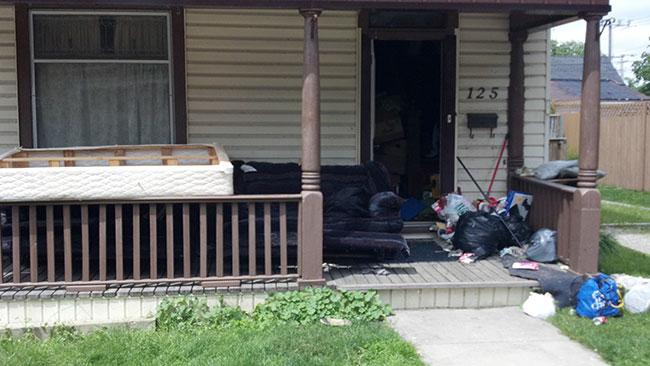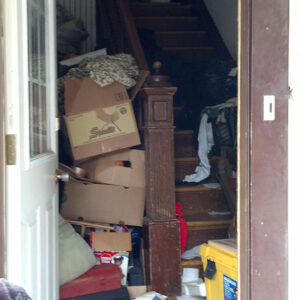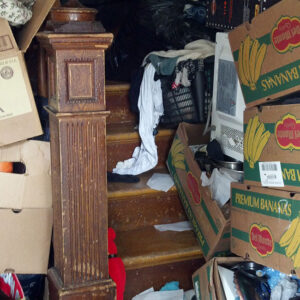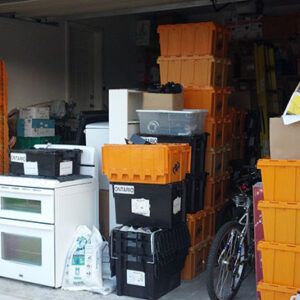
Features
Training
Back to Basics: Navigating the mess
August 14, 2023
By Mark van der Feyst
 Photo 4: The couch along with the mattress and garbage can be quickly removed from the porch and placed on the front lawn away from the travel path of the operation.
Photos by Mark van der Feyst
Photo 4: The couch along with the mattress and garbage can be quickly removed from the porch and placed on the front lawn away from the travel path of the operation.
Photos by Mark van der Feyst When we train new recruit firefighters in live fire environments, whether it is a fixed facility or an acquired structure, the environment inside the building is not as realistic as it should be or needs to be. A disconnect exists between reality and training in this arena with respect to the interior conditions and the level of housekeeping that is found in many residential structure fires.
Whenever a live fire training exercise is being conducted, we need to follow NFPA 1403 to ensure that all participants are not going to be put in harm, as well as the instructors. This will involve not having crowded or congested conditions within the burn facility like those found in many residential dwellings. For some departments, this is a health and safety issue with not promoting or providing the chance for any firefighter inside the burn facility to get entangled while doing a specific task for the evolution.
What do we mean by congested or poor housekeeping within a residential building? Look at Photos 1, 2 and 3. With these photos, you will see examples of congested interior conditions or poor housekeeping. We have heard of the term hoarding conditions as it relates to massive storage of garbage and junk within a residential building with stuff piled up from the floor towards the ceiling or stacked up in columns from floor to ceiling. Not every home is a hoarder home, but many are congested or have poor housekeeping inside.
With these types of conditions inside a structure, we are still required to navigate through it for search operations, hose advancement and fire suppression. When faced with this type of condition, for some firefighters, this may present a real challenge because they have not faced this type of environment before and do not have the confidence and skill to overcome it.
This is where the training environment needs to match the environments that we are going to face. This can be duplicated within the burn building or training building by adding in the furniture items, boxes, laundry baskets and other items that will be found within. This will not contradict NFPA 1403 as long as these items are not in the same room as the burn room. They can be in the rooms leading up to the burn room or in the pathway that leads to the burn room. This will provide for acclimation of the congested environment for the firefighter so that when they face this at an actual structure fire, it will not be a surprise or shock.
When arriving to the address of the residential structure fire, the size up will help to indicate what the inside conditions may look like. In Photo 4, you will see an example of this. In this photo, you are going to see congestion and poor housekeeping on the front porch. The main access door to the structure is also encroached on by the congestion. One job that the driver can do, after getting water to the nozzle, is to clear away some of the congestion from the door after the crew has made entry inside. In our photo example, the couch along with the mattress and garbage can be quickly removed from the porch and placed on the front lawn away from the travel path of the operation.
When conducting a search of the structure, a thermal imager will be a great asset. It will assist with showing what is a body and what is not. With zero visibility, it may be difficult to decipher what is a body and what is garbage or congestion using our gloved hands. With the thermal imager, we will be able to see and know quickly what is and what is not.
When searching, the team will have to climb over the congestion as opposed to trying to move it out of the way. Moving the congestion will only add more confusion and work later on in the operation. The basic tenants of search still apply in that occupants who are still inside will be found either on the floor, on a bed, couch or bathtub based upon the type of room they are in. Taking the time to search the upper portions of the room such as the countertops, tabletops, and appliances will only waste time for the search. Focus on the floor.
When a body has been located, verify that it is a body by getting up close with your search light. Look to see what features you are touching, such as face, hands, feet, torso, etc., before dragging the body or item to the exit point. If it is not a body, but rather a soft object that resembles a body, the focus can be quickly shifted back to the search and locating the occupant.
When advancing a hose line inside a structure that has congestion or poor housekeeping, the same tactics must be employed as with the search operation. This will involve climbing and/or moving over top of the congestion while advancing the line. The hose line being advanced in will get caught up with the congestion or even take some of it with it as it moves through the structure. This will require diligent hose management from the team to advance it while at the same time, dealing with the congested mess that is interfering with the line.
If applying water or painting the room or hallway while advancing, there is a good chance that the congested mess will be pushed away from the water stream hitting it or not moving and becoming water soaked as a result.
In going back to the beginning of our discussion on this topic, the disconnect with training can be fixed to bridge the gap so that when firefighters face this type of interior condition, they will not be caught off guard and will have the confidence to navigate the mess.
Mark van der Feyst has been in the fire service since 1999 and is currently a firefighter with the FGFD. Mark is an international instructor teaching in Canada, U.S. FDIC and India. He is the lead author of Fire Engineering’s Residential Fire Rescue & Tactical Firefighter books. Contact him at Mark@FireStarTraining.com.
Print this page
Advertisement
- B.C. wildfire fighters say more needs to be done to retain experienced firefighters
- Hawaii’s governor warns that scores more people could be found dead following wildfires on Maui


